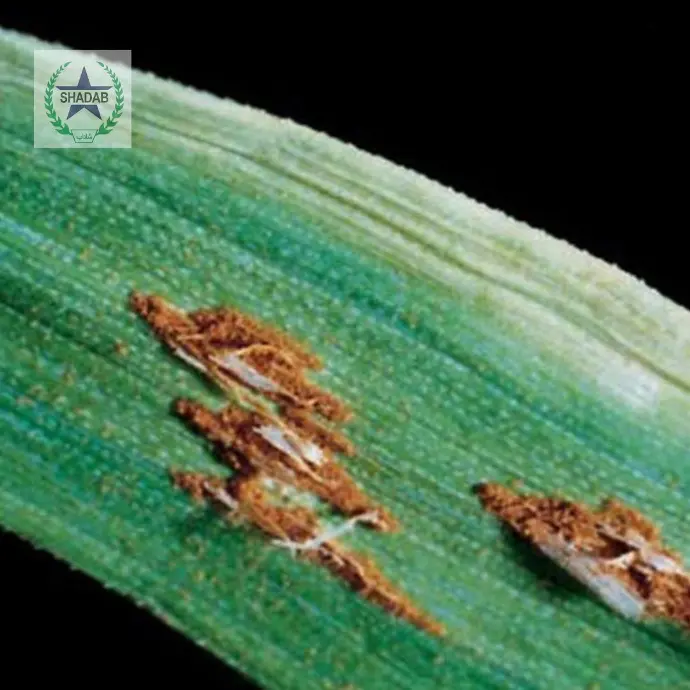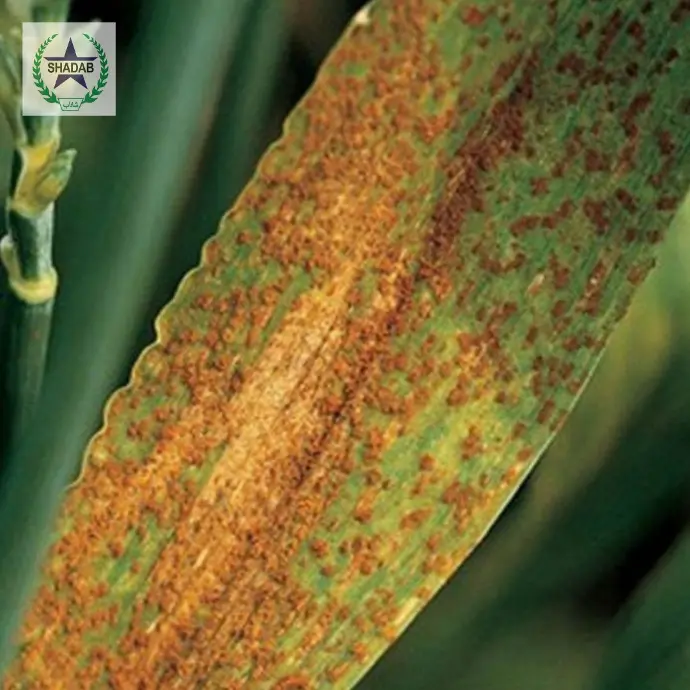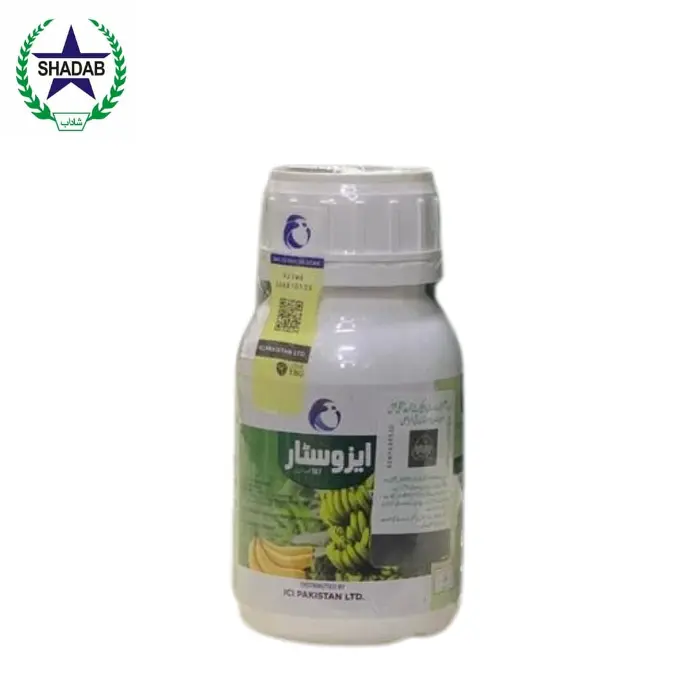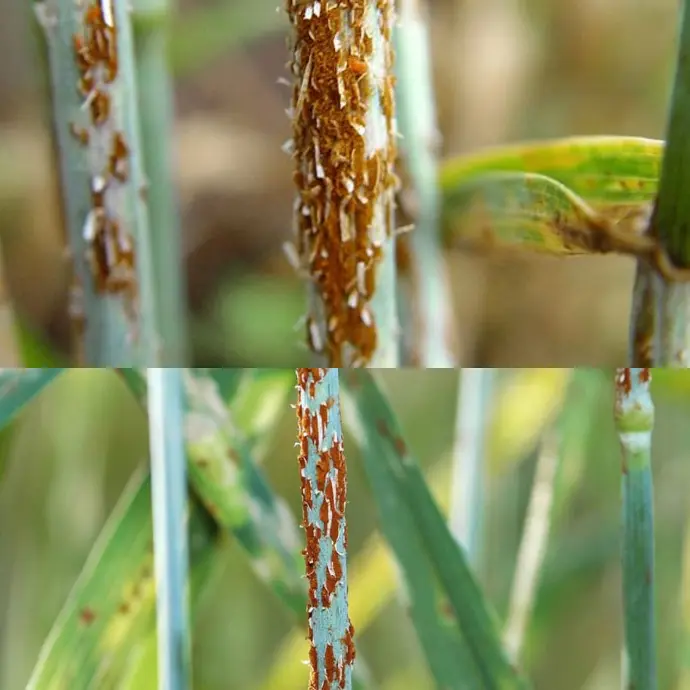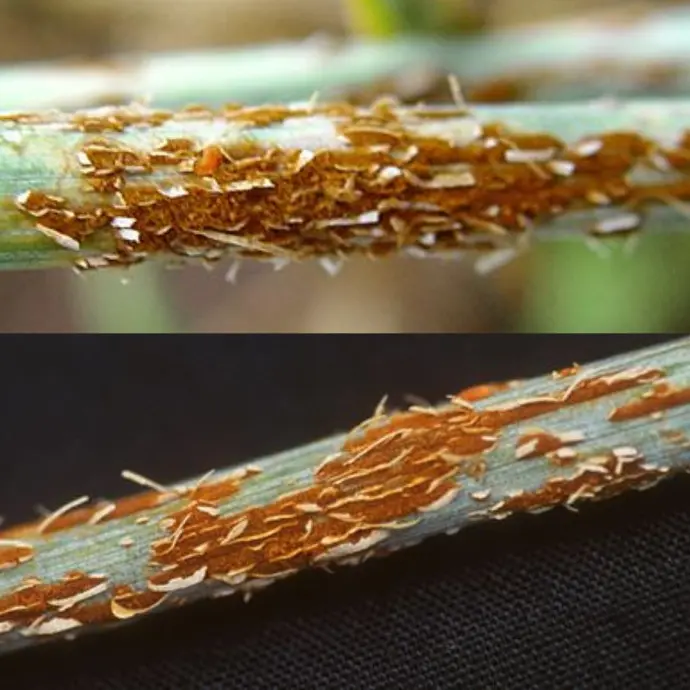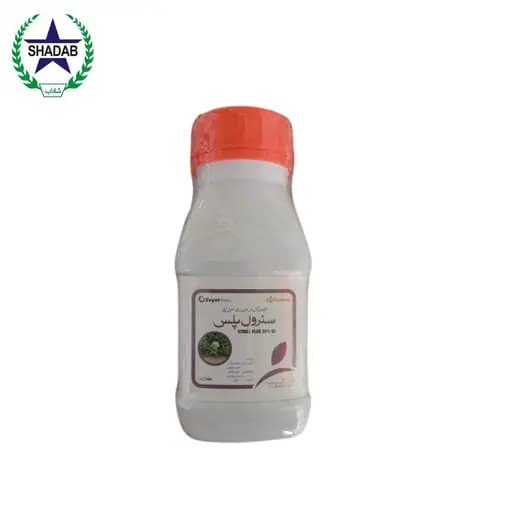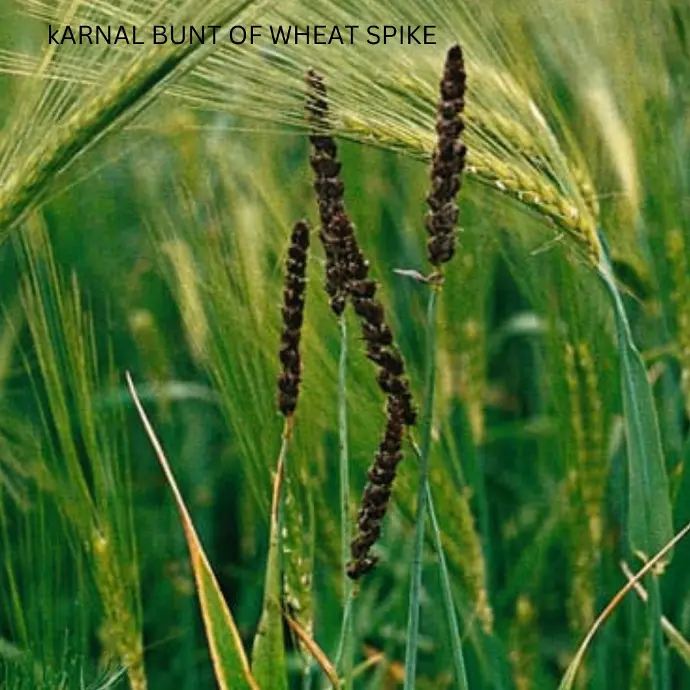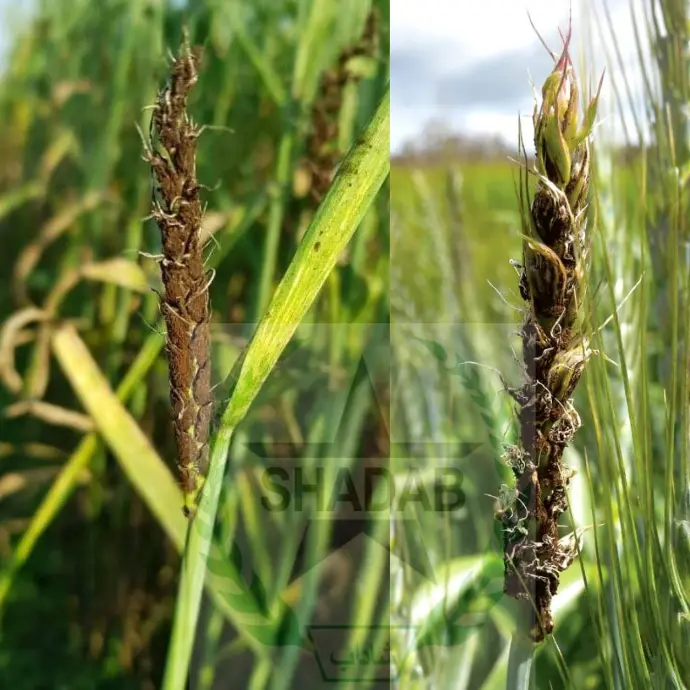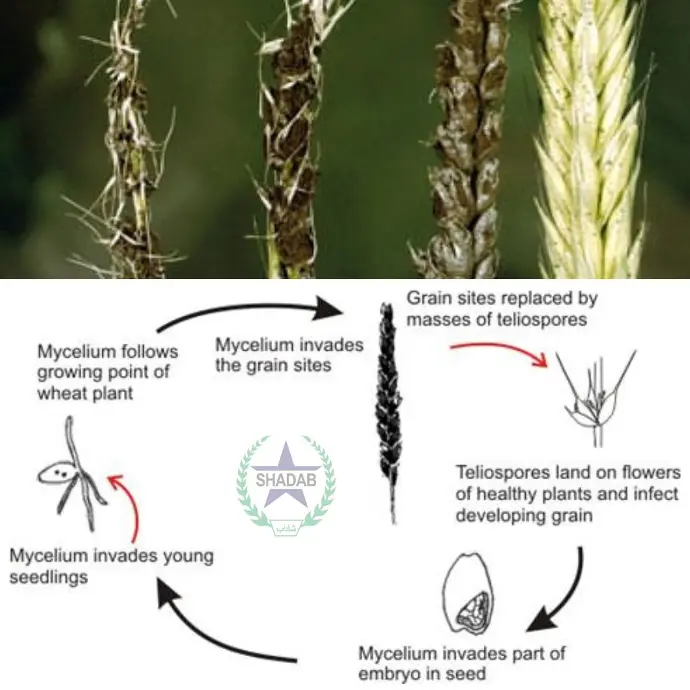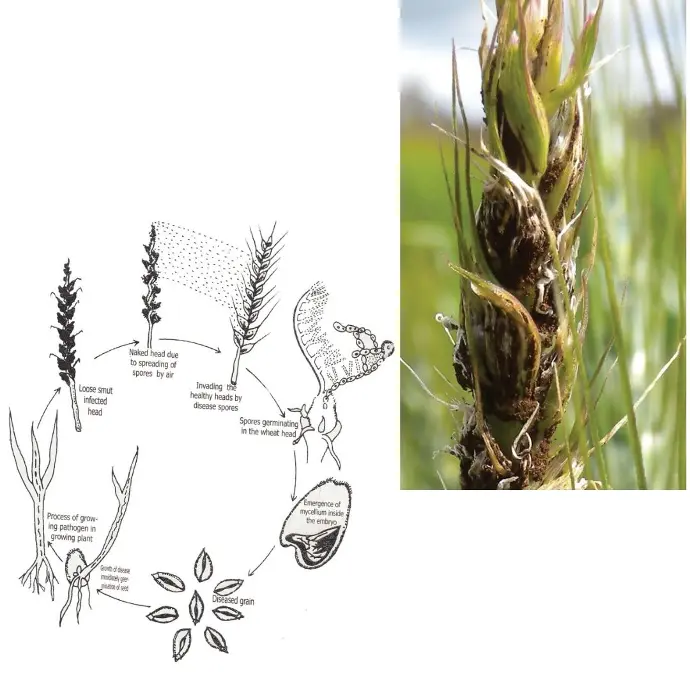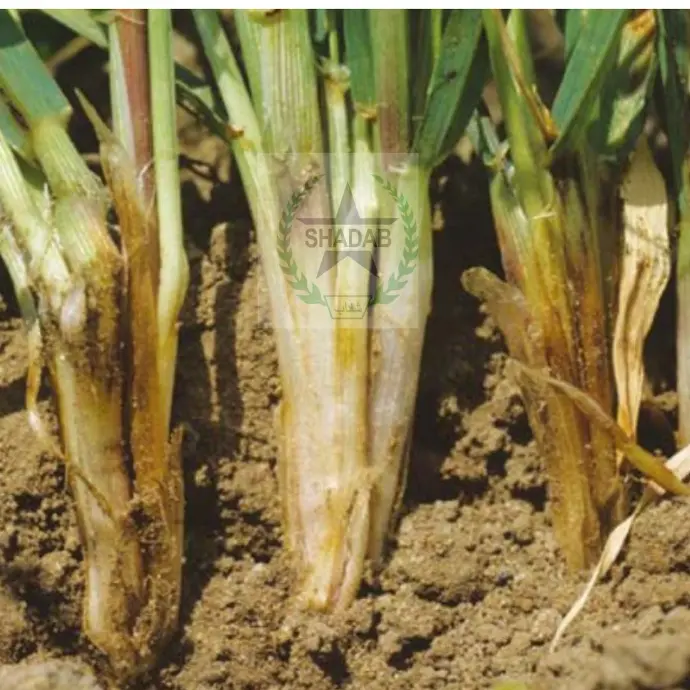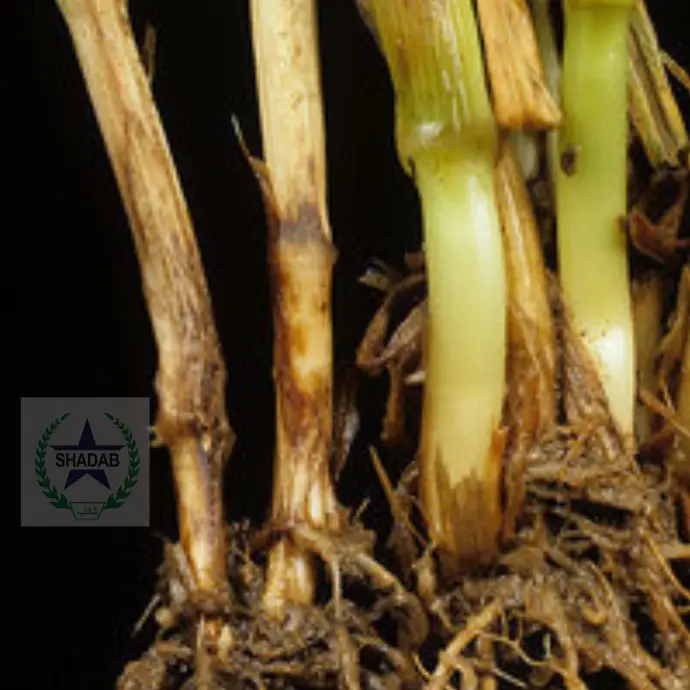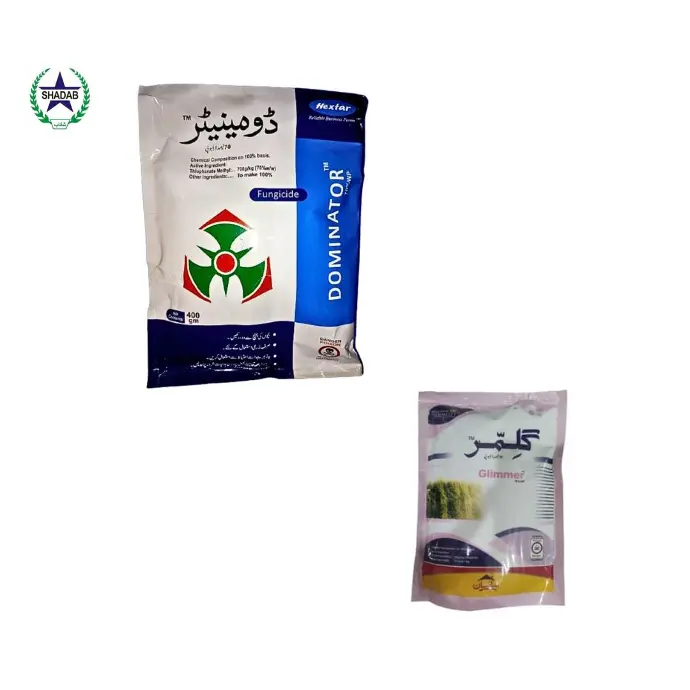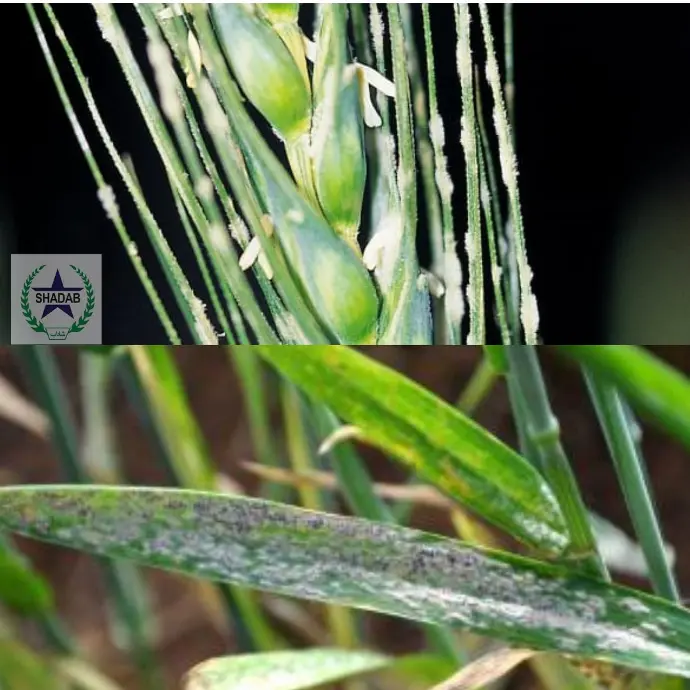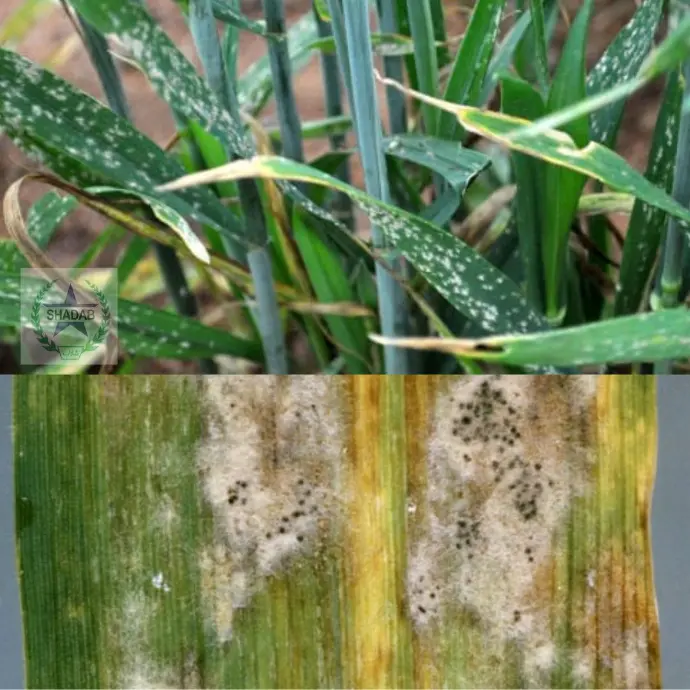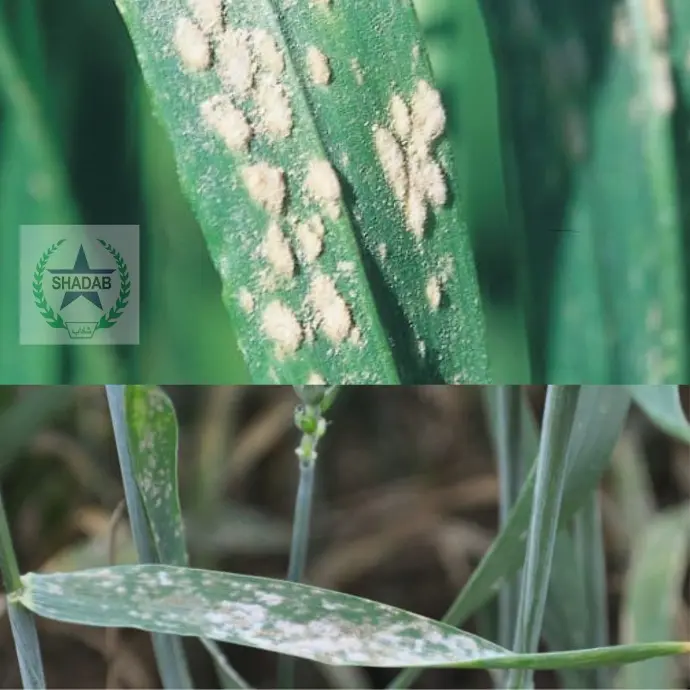WHEAT DISEASES AND THEIR MANAGEMENTS
Wheat Rust Disease
گندم کا زنگ ایک اہم بیماری ہے جو گندم کی فصل کے پتوں اور تنوں کو متاثر کرتی ہے، بنیادی طور پر فروری سے مارچ کے آخر تک ہوتی ہے۔ موسم سرما کی بارشیں اس بیماری کے پھیلاؤ میں اہم کردار ادا کرتی ہیں، جس سے اس کے پھیلاؤ کے لیے سازگار حالات پیدا ہوتے ہیں۔ زرد زنگ کے ابتدائی مراحل میں، لمبی لمبی لکیریں پتوں پر ظاہر ہوتی ہیں، جو بعد میں پتوں کی چادروں، ڈنٹھلوں اور گوندوں تک پھیل جاتی ہیں۔ یہ لکیریں uredosori کی قطاروں کی خصوصیت رکھتی ہیں، جس میں ہر پستول بیضوی شکل کی نمائش کرتا ہے۔ ٹیلیا یا ٹیلی یوٹوسوری کی تشکیل کبھی کبھار ہوتی ہے۔ جب یہ واقع ہوتے ہیں تو وہ لیموں پیلے ہوتے ہیں اور قطاروں میں ترتیب دیے جاتے ہیں، چھوٹے، بیضوی سے لکیری اور سیاہ دکھائی دیتے ہیں، اسی لیے اس حالت کو 'سٹرائپ رسٹ' کہا جاتا ہے۔ زرد زنگ کے مؤثر طریقے سے انتظام کرنے کے لیے، تجویز کی جاتی ہے کہ Azoxystrobin اور Tebuconazole کے مرکب کو 100 ملی لیٹر فی ایکڑ کی شرح سے، یا متبادل طور پر، Trifloxystrobin اور Tebuconazole 65 گرام فی ایکڑ کی مقدار میں استعمال کریں۔ یہ علاج بیماری کے اثرات کو کم کرنے اور گندم کی فصل کی صحت اور پیداواری صلاحیت کو یقینی بنانے کے لیے ضروری ہیں
Rust is a significant disease that impacts the leaves and stems of wheat crops, primarily occurring from February through the end of March. The winter rains contribute to the proliferation of this disease, creating favorable conditions for its spread. In the initial stages of Yellow Rust, elongated streaks manifest on the leaves, subsequently extending to the leaf sheaths, stalks, and glumes. These streaks are characterized by rows of uredosori, with each pustule exhibiting an oval shape. The formation of telia or teleutosori is infrequent; when they do occur, they are lemon-yellow and arranged in rows, appearing small, oval to linear, and black, which is why this condition is referred to as 'stripe rust.' To effectively manage Yellow Rust, it is recommended to apply a combination of Azoxystrobin and Tebuconazole at a rate of 100 ml per acre, or alternatively, Trifloxystrobin and Tebuconazole at a dosage of 65 grams per acre. These treatments are essential for mitigating the impact of the disease and ensuring the health and productivity of wheat crops.
Brown Rust Disease of Wheat
Brown Rust is characterized by the presence of round or oblong pustules that exhibit an orange hue, which are unevenly scattered across the leaves. These pustules are seldom observed on leaf sheaths or stems and do not appear in linear formations. Notably, the pustules associated with Brown Rust are larger than those found in yellow rust, and the uredosori typically rupture on the upper surface of the leaves.For effective management of Brown Rust, it is recommended to utilize a combination of Azoxystrobin and Tebuconazole at a rate of 100 ml per acre, or alternatively, Trifloxystrobin combined with Tebuconazole at a dosage of 65 grams per acre. These treatments are essential for controlling the spread and impact of this fungal disease.
بھورے زنگ کی خصوصیت گول یا لمبے لمبے پتوں کی موجودگی سے ہوتی ہے جو نارنجی رنگت کی نمائش کرتے ہیں، جو کہ پتوں میں غیر مساوی طور پر بکھرے ہوتے ہیں۔ یہ پسٹولز شاذ و نادر ہی پتوں کی چادروں یا تنوں پر دیکھے جاتے ہیں اور لکیری شکلوں میں ظاہر نہیں ہوتے ہیں۔ قابل ذکر بات یہ ہے کہ براؤن زنگ سے جڑے آبلے پیلے رنگ کے زنگ سے بڑے ہوتے ہیں اور uredosori عام طور پر پتوں کی اوپری سطح پر پھٹ جاتی ہے۔ 100 ملی لیٹر فی ایکڑ کی شرح، یا متبادل طور پر، Trifloxystrobin کو Tebuconazole کے ساتھ ملا کر 65 گرام فی ایکڑ کی خوراک میں۔ یہ علاج اس فنگل بیماری کے پھیلاؤ اور اثرات کو کنٹرول کرنے کے لیے ضروری ہیں۔
Stem Rust Disease of Wheat
The initial indications of Stem Rust manifest as elongated, reddish-brown pustules, predominantly located on the stem, and subsequently affecting the leaf sheaths, lamina, and floral structures. The stem experiences the most significant damage, as these uredial pustules develop, coalesce, and ultimately rupture the epidermis of the host, revealing numerous uredospores contained within.For effective management of Stem Rust, it is recommended to apply a combination of Azoxystrobin andTebuconazole Tebuconazole at a rate of 100 ml per acre, or alternatively, a mixture of Trifloxystrobin and Tebuconazole at a dosage of 65 grams per acre.
تنے کے زنگ کے ابتدائی اشارے لمبے، سرخی مائل بھورے پسٹولز کے طور پر ظاہر ہوتے ہیں، جو بنیادی طور پر تنے پر واقع ہوتے ہیں، اور بعد ازاں پتے کی چادروں، لامینا اور پھولوں کی ساخت کو متاثر کرتے ہیں۔ تنے کو سب سے زیادہ نقصان ہوتا ہے، کیونکہ یہ پیشاب کی نالیوں کی نشوونما ہوتی ہے، اکٹھے ہو جاتے ہیں، اور بالآخر میزبان کے ایپیڈرمس کو پھٹ جاتے ہیں، جس سے اس کے اندر موجود متعدد uredospores کا پتہ چلتا ہے۔ تنے کی زنگ کے مؤثر انتظام کے لیے، یہ تجویز کیا جاتا ہے کہ Azoxystrobin اورTebuconazole کا مرکب استعمال کریں۔ 100 ملی لیٹر فی ایکڑ کی شرح، یا متبادل طور پر، Trifloxystrobin اور Tebuconazole کا مرکب 65 گرام فی ایکڑ کی خوراک پر۔
Kernel bunt of Wheat
This disease primarily targets the stems of the crop, leading to detrimental effects on the overall health of the grains. The symptoms of the condition become evident only during the development phase of the grains. The pathogen exerts its influence on the grains in a partial manner, resulting in the affected areas transforming into a black, spore-laden mass.In cases of severe infection, the spikelets exhibit significant deterioration, causing the glumes to separate and frequently detach, ultimately falling to the ground. To effectively manage Kernal Bunt, it is recommended to apply either a combination of Azoxystrobin and Tebuconazole at a rate of 100 ml per acre or Trifloxystrobin and Tebuconazole at a dosage of 65 grams per acre.
یہ بیماری بنیادی طور پر فصل کے تنوں کو نشانہ بناتی ہے، جس سے اناج کی مجموعی صحت پر نقصان دہ اثرات مرتب ہوتے ہیں۔ حالت کی علامات صرف اناج کی نشوونما کے مرحلے کے دوران ہی ظاہر ہوتی ہیں۔ روگزنق جزوی طور پر دانوں پر اپنا اثر ڈالتا ہے، جس کے نتیجے میں متاثرہ علاقے سیاہ، بیضوں سے بھرے ماس میں تبدیل ہو جاتے ہیں۔ شدید انفیکشن کی صورتوں میں، اسپائیکلٹس نمایاں طور پر بگڑ جاتے ہیں، جس کی وجہ سے گلومز الگ ہو جاتے ہیں اور کثرت سے الگ ہو جاتے ہیں۔ زمین پر گرنا. کرنل بنٹ کے مؤثر طریقے سے انتظام کرنے کے لیے، تجویز کی جاتی ہے کہ Azoxystrobin اور Tebuconazole کا مرکب 100 ملی لیٹر فی ایکڑ کی شرح سے یا Trifloxystrobin اور Tebuconazole 65 گرام فی ایکڑ کی مقدار میں استعمال کریں۔
Loose Smut of Wheat
Loose Smut is characterized by the transformation of flowers into a dark, powdery mass of spores. The glumes and all other floral components are completely substituted by these spores. In the inflorescence, only the axis, the tips of the glumes, and the awns persist, while the remaining structures are entirely overtaken by spores. To manage Loose Smut effectively, it is recommended to treat the seeds with thiophanate methyl at a rate of 2 grams per kilogram.
ڈھیلے سمٹ کی خصوصیت پھولوں کے بیضوں کے سیاہ، پاؤڈری ماس میں تبدیل ہوتی ہے۔ گلومز اور دیگر تمام پھولوں کے اجزا مکمل طور پر ان بیضوں سے بدل جاتے ہیں۔ پھولوں میں، صرف محور، گلومز کے سرے، اور آون برقرار رہتے ہیں، جبکہ باقی ڈھانچے مکمل طور پر بیضوں کے زیر اثر ہوتے ہیں۔ لوز سمٹ کے مؤثر طریقے سے انتظام کرنے کے لیے، یہ تجویز کی جاتی ہے کہ بیجوں کو 2 گرام فی کلو گرام کی شرح سے تھیوفینیٹ میتھائل کے ساتھ علاج کریں۔
Zymoseptoria tritici of Wheat
Zymoseptoria tritici is a fungal pathogen that manifests as pale grey to dark brown lesions primarily on the leaves, with some impact on the stems and heads of the plant. A key identifying characteristic of Septoria tritici blotch is the presence of small black fruiting bodies, known as pycnidia, embedded within these lesions. These minute black spots contribute to the distinctive speckled appearance of the affected areas.To effectively manage Septoria leaf blotch, it is recommended to apply a mixture of azoxystrobin and difenoconazole at a concentration of 32.5% at a rate of 200 ml per acre. Alternatively, a combination of azoxystrobin and tebucanozole at 50% can be utilized at a dosage of 100 ml per acre for control of this fungal disease.
Zymoseptoria tritici ایک فنگل پیتھوجین ہے جو بنیادی طور پر پتوں پر ہلکے بھوری رنگ سے گہرے بھورے گھاووں کے طور پر ظاہر ہوتا ہے، جس کا کچھ اثر پودے کے تنوں اور سروں پر پڑتا ہے۔ Septoria tritici blotch کی ایک اہم شناخت کرنے والی خصوصیت ان گھاووں کے اندر سرایت کرنے والے چھوٹے سیاہ پھل دار اجسام کی موجودگی ہے، جسے pycnidia کہا جاتا ہے۔ یہ منٹ کے سیاہ دھبے متاثرہ علاقوں کی مخصوص دھبوں والی ظاہری شکل میں اہم کردار ادا کرتے ہیں۔ Septoria leaf blotch کے مؤثر طریقے سے انتظام کرنے کے لیے azoxystrobin اور difenoconazole کے مرکب کو 200 ملی لیٹر فی ایکڑ کی شرح سے 32.5 فیصد کے ارتکاز پر لگانے کی سفارش کی جاتی ہے۔ متبادل طور پر، azoxystrobin اور tebucanozole کا 50% مرکب 100 ملی لیٹر فی ایکڑ کی مقدار میں استعمال کیا جا سکتا ہے تاکہ اس فنگل بیماری پر قابو پایا جا سکے۔
Foot Rot Disease of Wheat
Foot Rot of Wheat is characterized by the appearance of dark brown streaks on the leaf sheaths of seedlings, which represent the most common initial symptom. As the disease advances, these streaks become water-soaked at the bases of the stems and spread upward along the first internode. Infections that occur at the ligule facilitate the transfer of mycelium to newly emerging leaves, allowing the fungus to ascend through the growing plant. To manage Foot Rot, it is recommended to apply Thiophenate methyl at a rate of 1000 grams per acre.
گندم کے فوٹ روٹ کی خصوصیت پودوں کے پتوں کے پروں پر گہری بھوری لکیروں کی ظاہری شکل سے ہوتی ہے، جو سب سے عام ابتدائی علامت کی نمائندگی کرتی ہے۔ جیسے جیسے بیماری بڑھتی ہے، یہ لکیریں تنے کی بنیادوں پر پانی میں بھیگی ہو جاتی ہیں اور پہلے انٹرنوڈ کے ساتھ اوپر کی طرف پھیل جاتی ہیں۔ ligule پر ہونے والے انفیکشن نئے ابھرتے ہوئے پتوں میں مائسیلیم کی منتقلی میں سہولت فراہم کرتے ہیں، جس سے فنگس بڑھتے ہوئے پودے کے ذریعے اوپر جاتی ہے۔ فوٹ روٹ کو کنٹرول کرنے کے لیے، 1000 گرام فی ایکڑ کی شرح سے تھیوفینیٹ میتھائل لگانے کی سفارش کی جاتی ہے۔
Powdery Mildew
Powdery mildew in wheat appears under favorable conditions as a white, fluffy fungal growth on the surfaces of leaves, as well as on the awns and glumes of the wheat head. Initial signs of the disease may present as yellow spots on the leaves prior to the development of mycelial growth. The presence of wheat powdery mildew (WPM) spores can lead to infection at any time during the growing season, although the progression of symptoms typically occurs from the lower leaves to the upper ones.Plants that are in their early growth stages or have been treated with nitrogen are particularly susceptible to more severe infections, as rapidly growing tissues are more vulnerable. To effectively manage this disease, it is recommended to apply a combination of 50% Tebuconazole and Azoxystrobin at a rate of one acre, or alternatively, a mixture of Tebuconazole and Trifloxystrobin at a concentration of 75% at 65 grams per acre.
گندم میں پاؤڈری پھپھوندی سازگار حالات میں پتوں کی سطحوں کے ساتھ ساتھ گندم کے سر کی چوٹیوں اور گوندوں پر سفید، پھپھوندی والی پھپھوندی کی نشوونما کے طور پر ظاہر ہوتی ہے۔ بیماری کی ابتدائی علامات مائیسیئل کی نشوونما سے پہلے پتوں پر پیلے دھبوں کے طور پر ظاہر ہو سکتی ہیں۔ گندم کے پاؤڈری پھپھوندی (WPM) کے بیضوں کی موجودگی بڑھتے ہوئے موسم کے دوران کسی بھی وقت انفیکشن کا باعث بن سکتی ہے، حالانکہ علامات کا بڑھنا عام طور پر نچلے پتوں سے اوپری پتوں تک ہوتا ہے۔ نائٹروجن کے ساتھ زیادہ شدید انفیکشن کے لیے خاص طور پر حساس ہوتے ہیں، کیونکہ تیزی سے بڑھنے والے ٹشوز زیادہ کمزور ہوتے ہیں۔ اس بیماری کو مؤثر طریقے سے کنٹرول کرنے کے لیے، 50% Tebuconazole اور Azoxystrobin کے مرکب کو ایک ایکڑ کی شرح سے یا متبادل طور پر Tebuconazole اور Trifloxystrobin کا مرکب 75% کے ارتکاز پر 65 گرام فی ایکڑ لگانے کی سفارش کی جاتی ہے۔
